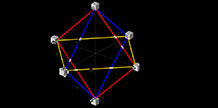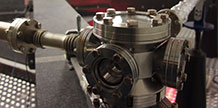Introducing GINGER
The General Theory of Relativity predicts that non-static, stationary mass-energy distributions affect spacetime giving rise to a phenomenon known as frame-dragging, the rotation of a massive object would distort the spacetime metric, making the orbit of a nearby test particle precess. The first frame-dragging effect was derived in 1918 by the austrian physicists Josef Lense and Hans Thirring, and it is also known as the Lense-Thirring effect.
GINGER (Gyroscopes IN GEneral Relativity) is an experiment aimed to verify the deformation of the time-space metrics due to the Earth spinning motion (Lense-Thirring effect). Three mutually orthogonal laser gyroscopes in a octahedral frame will measure the Earth rotation rate with a relative inaccuracy lower than 10-9.
The comparison of this measurement on the rotating Earth with the sidereal time given by the very large base interferometer array will give the measure of the effect. The experiment needs to be located in an underground laboratory (Gran Sasso INFN national laboratory), in order to reduce the noise induced by atmospheric and hydrologic perturbations.







